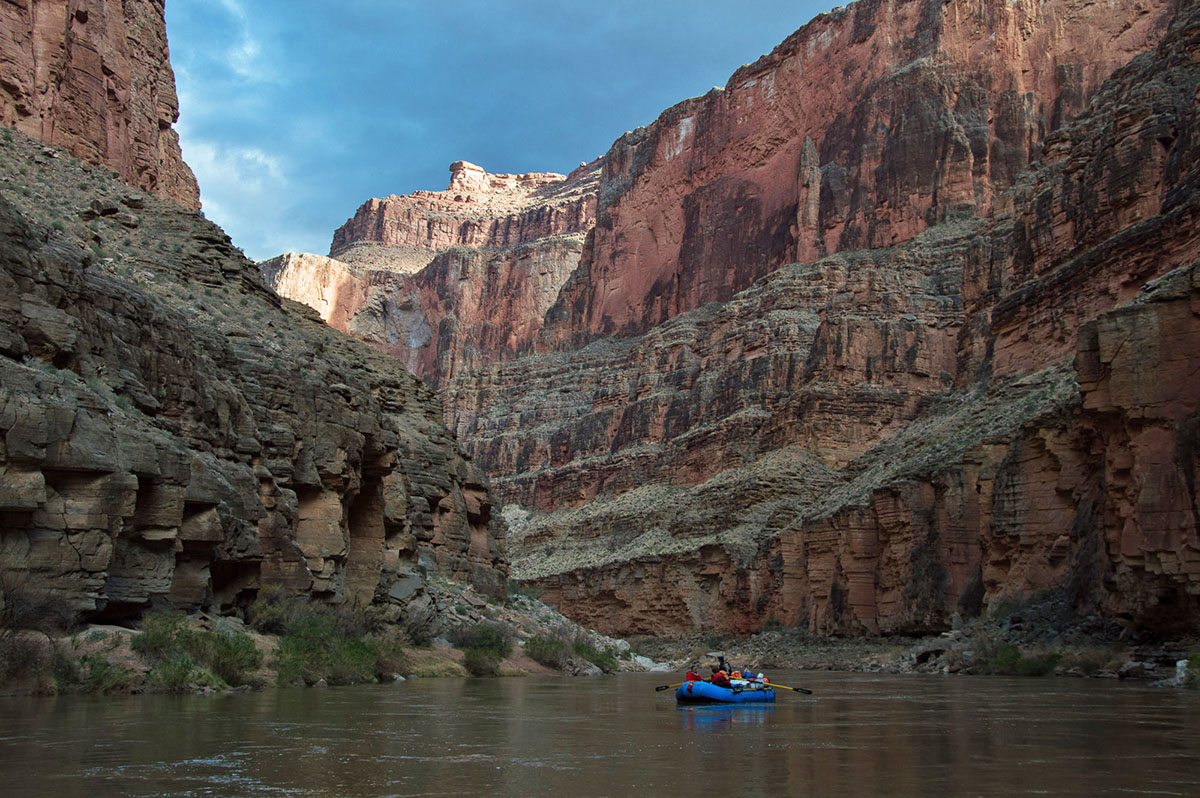
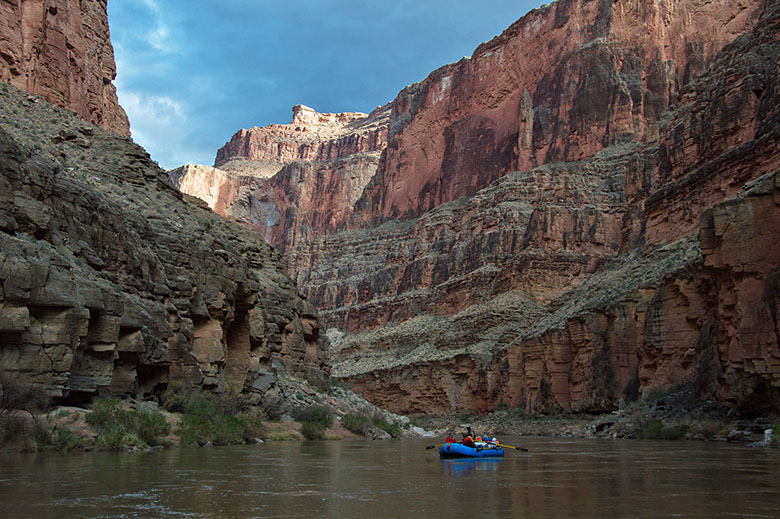
Millions travel just to stand on the edge of the Grand Canyon, gaze across the expanse, and peer into the abyss. When you’re lucky enough to see the river far below, it seems like nothing more than a tiny, shimmering ribbon. From the bottom, however, it’s a force that carves through miles of rock, the lifeblood that nurtures the desert, and the singular vein that gives access to the canyon’s wild corridors. Floating the Colorado River through the Grand Canyon is one of the most coveted wilderness experiences in North America, and those who venture out for a few weeks will escape civilization more completely than most people do in a lifetime. Especially in the wintertime.
During the summer when the blazing Southwestern sun dominates the sky, the Colorado River is teeming with guided outfits. In these warmer months, face-shots of cold water are refreshing and huge rapids dance on the horizon, tossing waves into the hot air like confetti. Boaters float the sun-scorched canyon in shorts and sun hats, cans of beer in hand.
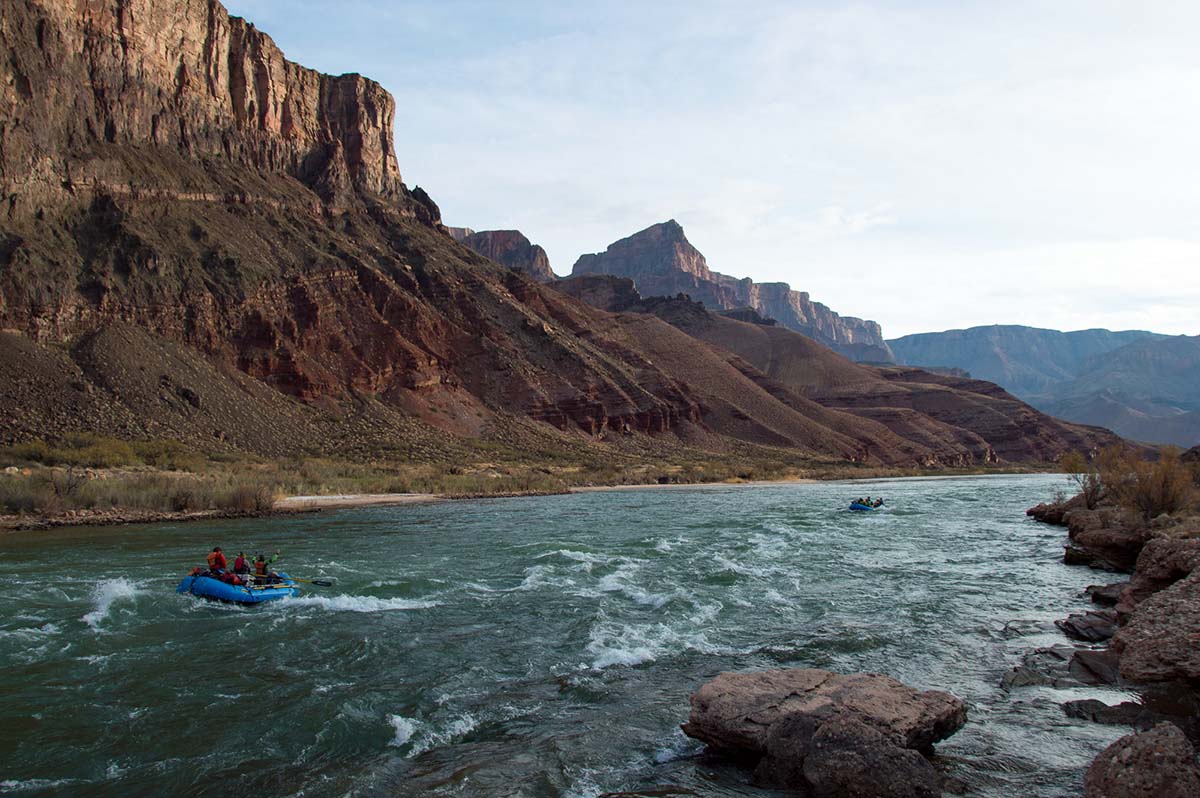
In the winter, average temperatures plummet (highs are in the 40s and 50s instead of pushing triple digits), the sun hangs lower, and a different regime takes over altogether. This is the time for private boaters who improve their chances of winning the permit lottery by throwing their hats in the ring for off-season dates. And winter is unpopular for good reason: short days, freezing nights, and frigid water make multiple weeks in The Grand more akin to survival than summer vacation. But could it be worth it for the adventure? Might the cold and desolation add to the experience? The day after Christmas of 2017, I set off with a crew of 16 to find my answer.
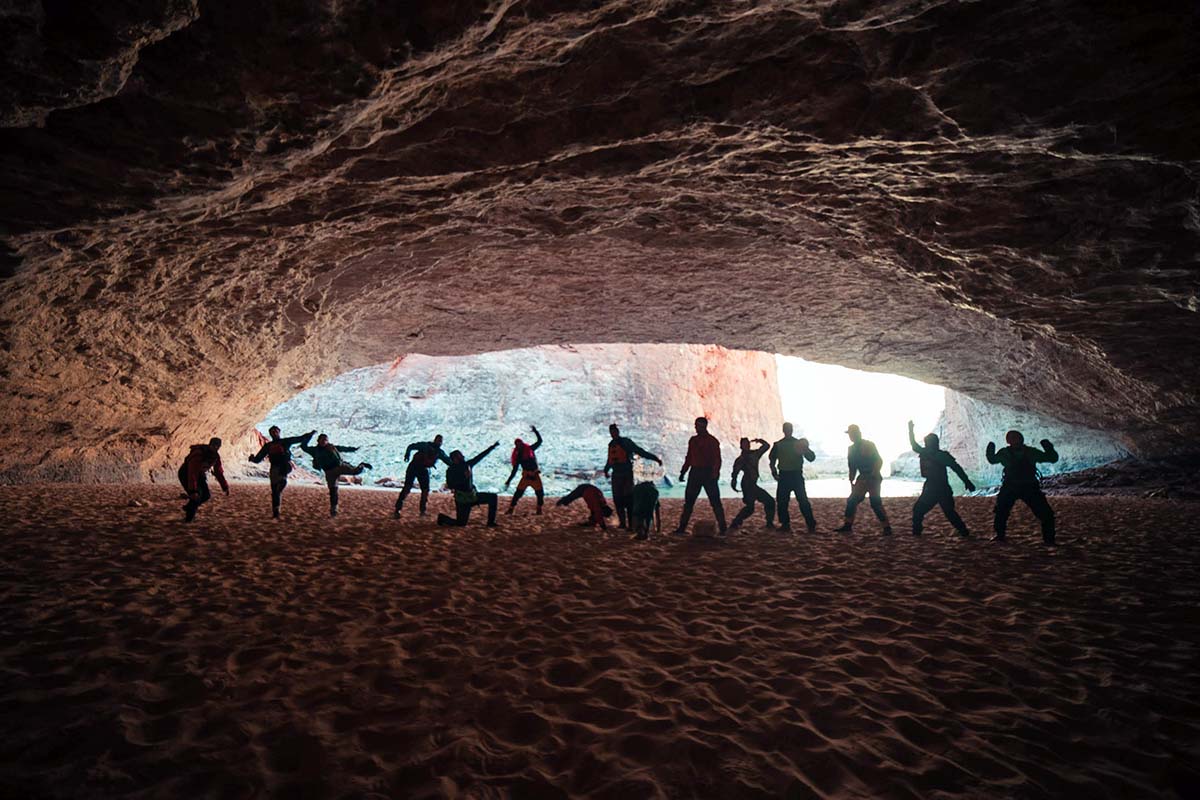
We were a band of friends, all connected in varying degrees by the town of Flagstaff, Arizona—though some of us had since moved elsewhere. A few were seasoned Grand Canyon boaters, but most were newcomers to the river. We were all thrilled to be reuniting as friends in such a significant place, but certainly nervous for the trials we would face in the winter canyon. I myself had floated the Colorado once before but in a kayak—a mode of whitewater travel I am well versed with. This would be my first time rowing an 18-foot rubber raft fully loaded with gear, the contrast akin to steering a cargo barge versus a speedboat. Experienced but far from expert, I was caught between blissful ignorance and confidence. I’d seen what these huge rapids could do and knew what the winter weather could bring. My mind was a class 9 rapid of “what ifs.”
Even in the summer, a typical day on the Colorado is no pleasure cruise. The rigors of navigating the river, moving camp each day, staying fed and hydrated, fighting off the fine sand’s creep into every nook and cranny, and keeping the peace amongst the group can be a sun up to sun down effort. Subtract dozens of degrees Fahrenheit and hours of daylight, and these challenges are compounded. Whitewater, rain, wind, and shade mean that dampness pervades and cold cuts straight to the bone. Forget the sun shirt and shorts of the summer months—in winter we armor ourselves with dry suits, fleece layers, down sleeping bags, tents, and a wood stove. And most importantly, when the sun withholds its warmth and gaze for the majority of the day, the crew must remember to bring, and maintain, a sunny disposition.
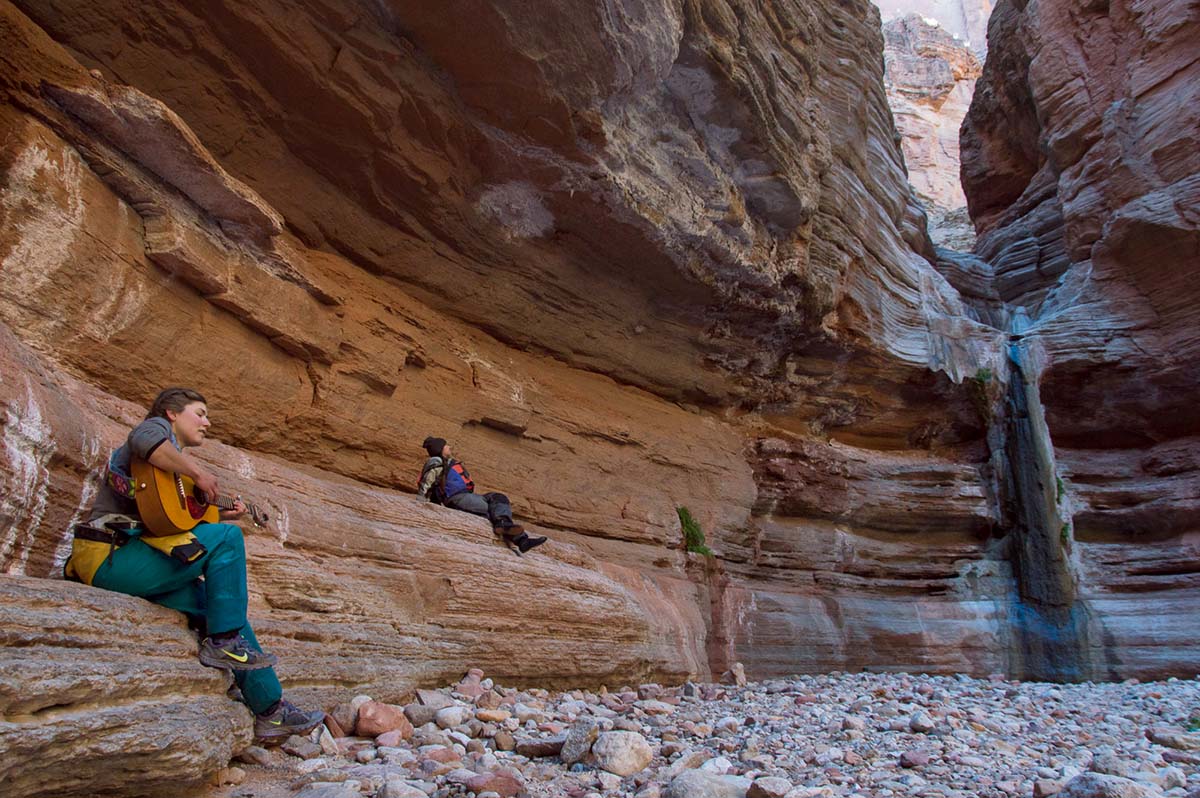
The trip started off as well as we could have hoped, with the initial eight days flowing by without major incident. The only hiccup we experienced came on Day 1, when a novice oarsman got a healthy dunk in reality by the river’s first major rapid. It kicked his raft nearly vertical, dumping him into the water and leaving his passengers to take the oars and pull him in. We all took note of this crash course in hydraulics, and with direction from the experienced rowers in our crew, made clean work of the rest of the rapids. Until Day 9 that is.
The day began with a bittersweet exchange, when six of our friends left the canyon to return to real life, on the trail passing six others hiking in to join us for the next fourteen days of adventure. Among those departing were our only two Grand Canyon veteran rowers. Now, only our guidebooks and slowly growing familiarity would see us through the canyon’s biggest whitewater yet to come.

We arrive at Horn Creek Rapid within an hour of casting off with our replenished crew, two of which are seeing the bottom of the canyon for the first time. Their immersion is instant, as the day’s itinerary includes the intimidating Inner Granite Gorge. Here, dark walls of contorted rock rise sharply on either side, blocking any view of the mile-high canyon rim and obscuring the warmth and comfort of the sun. The water moves swiftly, writhing and boiling through what looks like a dark underworld, and the roar of impending whitewater resounds long before the horizon line appears. Spots of slack water are few, but thankfully, there happens to be an eddy just large enough for our five rafts about 100 yards above Horn Creek Rapid.
We pull into the eddy to scout from shore, clambering out of our boats onto dry land. Gazing at Horn Creek Rapid, we discuss which path to follow through the fray and the order in which we will launch. The intended line is down the middle, threading a narrow gap between two dangerous rocks and holding on through the crashing waves that follow. After a few jumping jacks to warm up, we turn back to the boats.
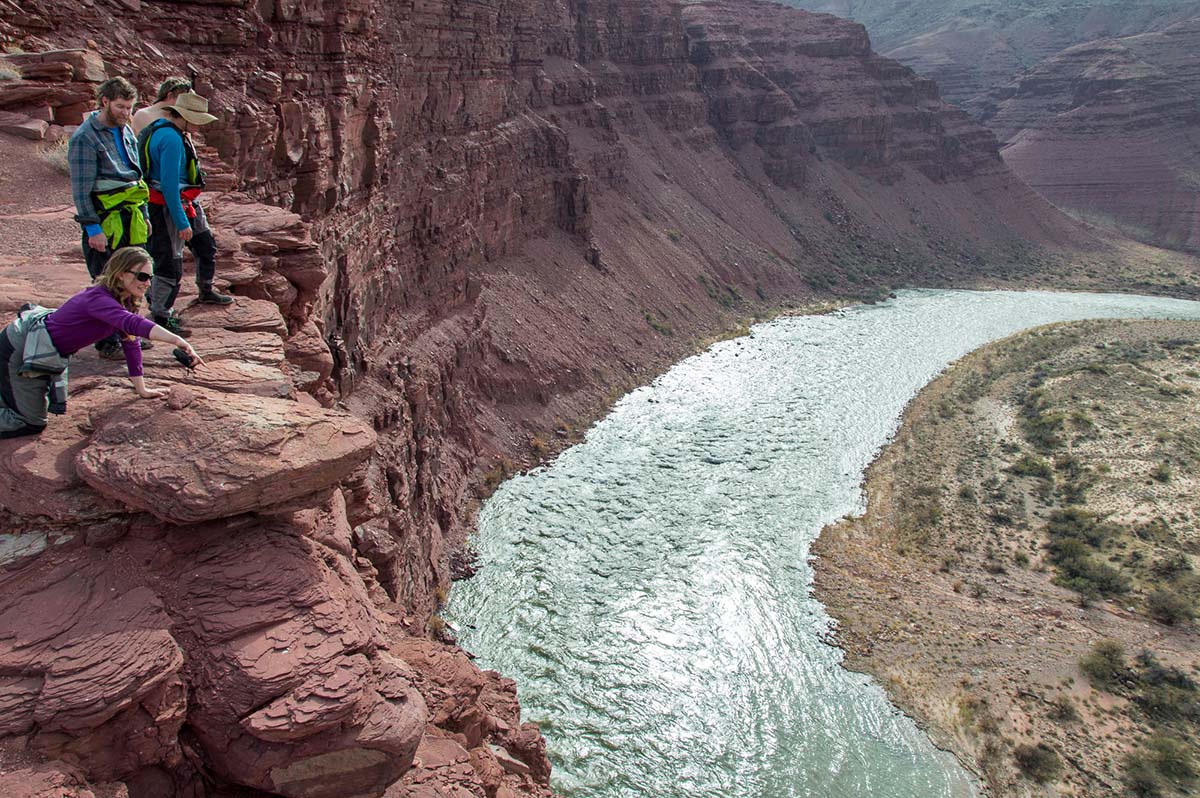
Our plan is well made but poorly executed. Once in the rafts, anxiety leads to confusion, and some shove off too close to one another. Suddenly three rafts are in the current, all aiming for the center of a rapid where there is only room for one. We are far too close together. Bumping rafts means getting knocked off course, pinning on a rock, flipping, frigid water, deep holes, darkness, hypothermia—basically all of our biggest fears rolled into one.
I am at the oars of one of these boats, and I realize the trouble at once. I have a split second to follow course for collision or find a way out. I spot another gap on the far right that might be safe. Maybe I can make it. Maybe the two other boats will be able to pull through with one less raft in the mix. I yell over my shoulder, “I’m going right!” and push hard on my oars to steer away. Sharply curled waves appear on my right side and I pull to switch my boat’s direction. The momentum of my one-ton load dwarfs my human strength. I begin to move back left—but not enough. The first few waves crash over the bow of my raft and drench my two passengers. Ahead, the biggest surge wells up. The current sweeps our boat straight toward it, my strength again no match. We are grabbed by the building wave. The raft stands vertical for an instant before the crest crashes down and finishes us.
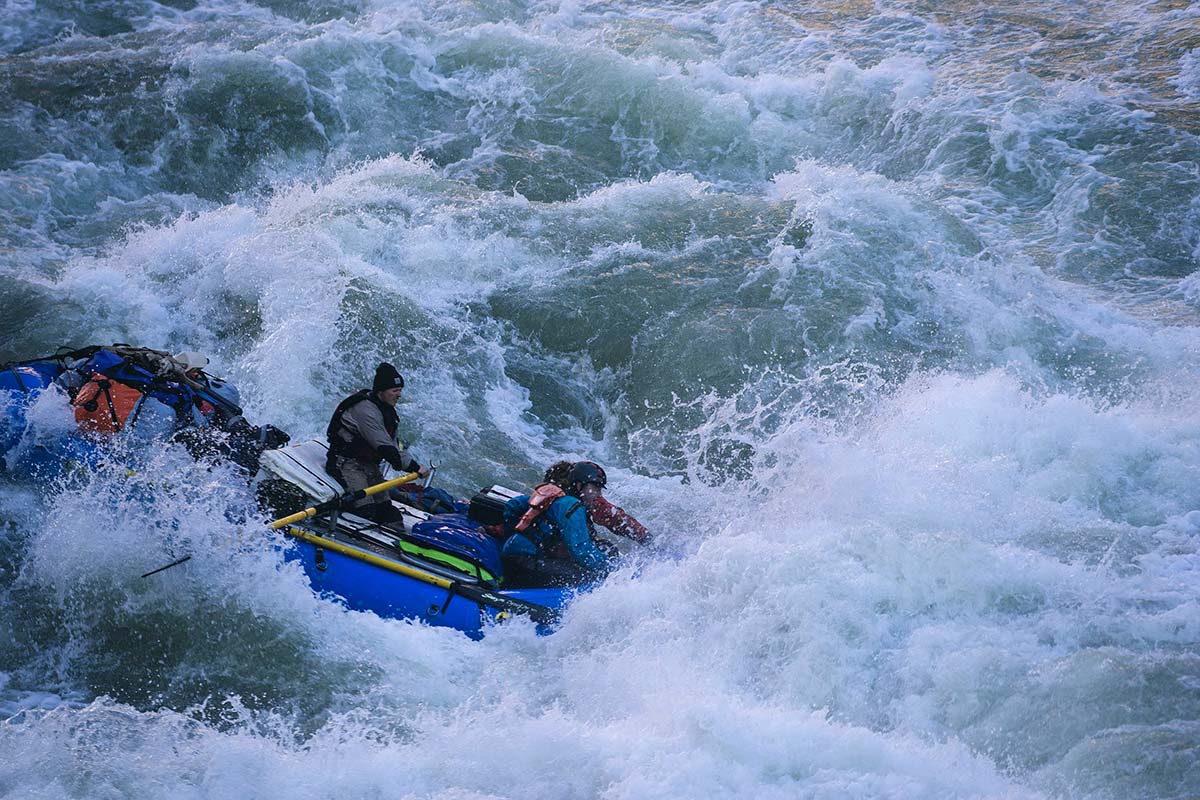
My two passengers and I are immediately submerged beneath the capsized raft. A shock of cold water hits me and I snap to my senses. I drag myself up on the slick rubber underside. Seeing one friend clinging to a handle, I scramble over to hoist him up. The other is swept farther away, soon pulled to safety by the boat behind us. Our team rallies impressively, throwing me a rope and towing the disabled raft into an eddy. From there, many of us clamber on top to attach lines, lean back, and tip it over. The other two rafts in our cluster luckily have stayed upright, just barely, and the two others also are fine. Finally, all five boats and all sixteen people are together in the eddy, safe.
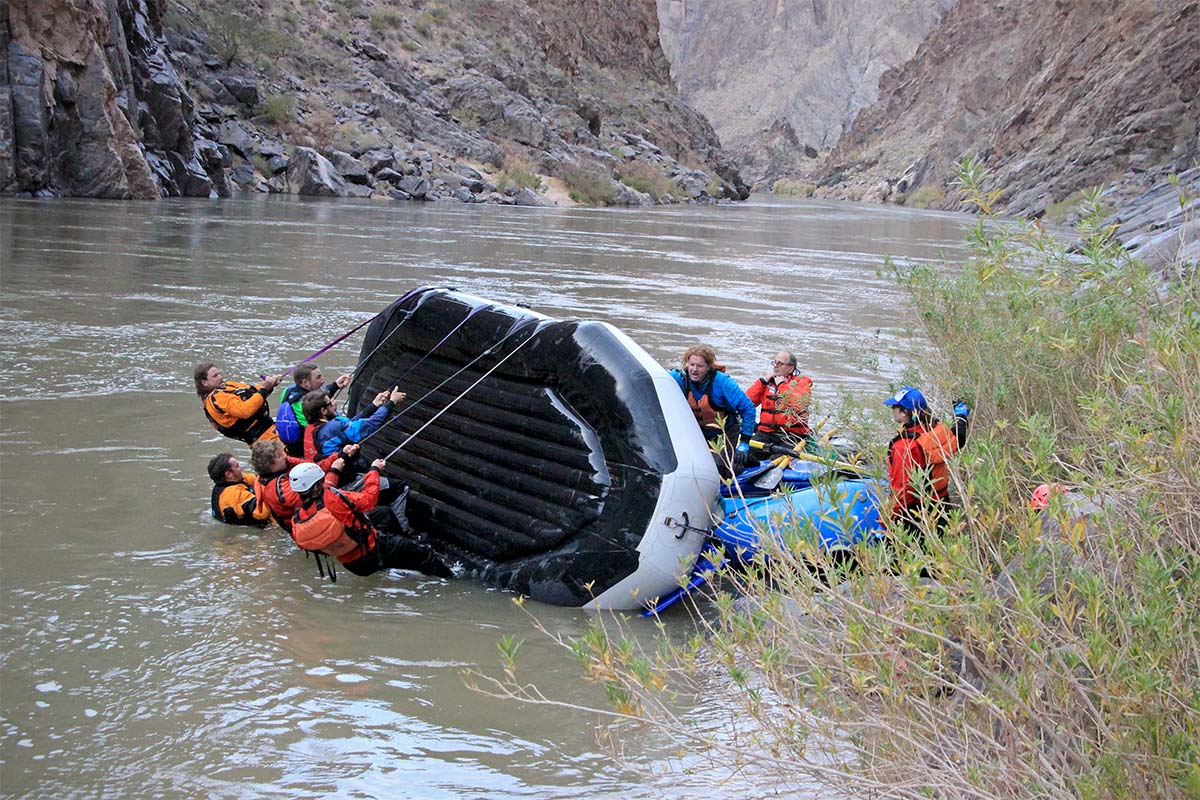
We recovered smoothly, but the mood of the trip takes a turn. In one afternoon our crew moved from sunny celebration of the coming of new friends to a cold reminder of the first day’s lesson: mistakes have consequences. Shivering and somber, we drift on through easier water to the night’s camp a few miles downstream. Were it summer, we would find a sun-drenched sandy beach with a large eddy pool nearby for swimming. Today, all is shrouded in shadow and January’s sun hides behind sheer cliffs. We camp within foreboding earshot of the next big rapid.
The coming days bring one more raft flip and some near misses, along with clean lines and great successes. There are clouds, rain, and frost, but also sunshine, games, campfires, hot toddies, and laughter. They say that contrast is the spice of life, and a winter Grand Canyon trip couldn’t be better proof. We enjoy every ray of sunshine and each moment of comfort tenfold, knowing it might not last. On Day 23, we reach our takeout right on schedule, finishing all 280 miles of the Colorado River that weave through the Grand Canyon from Lees Ferry to Pearce Ferry. We have completed the trip that so many covet, and we have done it during the coldest days of the year.
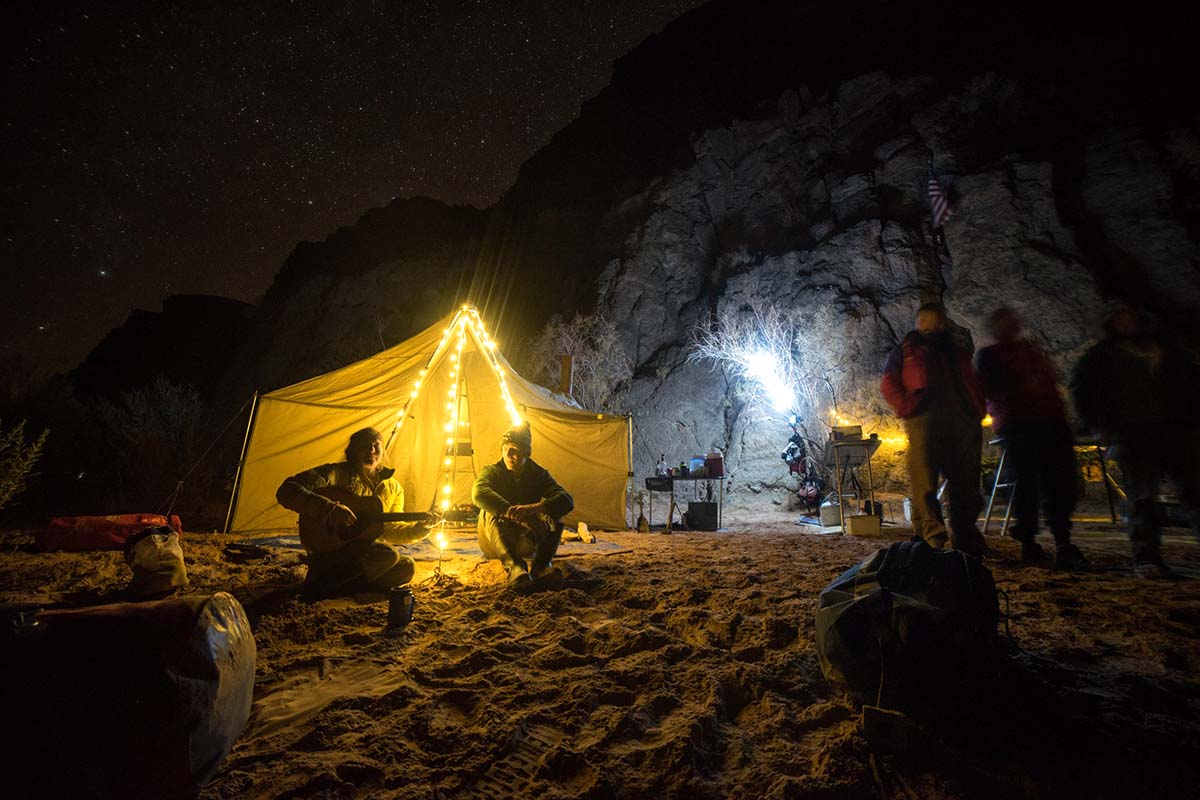
To preserve a delicate ecosystem and a wilderness experience for those who visit, the National Park Service enforces a ceiling on the number of people that can launch on the river any given day. Groups may have a maximum of 16 people and take up to 25 days to travel the 226 miles from Lees Ferry to Diamond Creek. No individual may do more than one trip per year, unless by employment on commercial or research operations. The upside to this policy is that all who travel through the Canyon are ensured a degree of solitude with few traces of those who have come before. The downside: you’re lucky if you get to go at all.
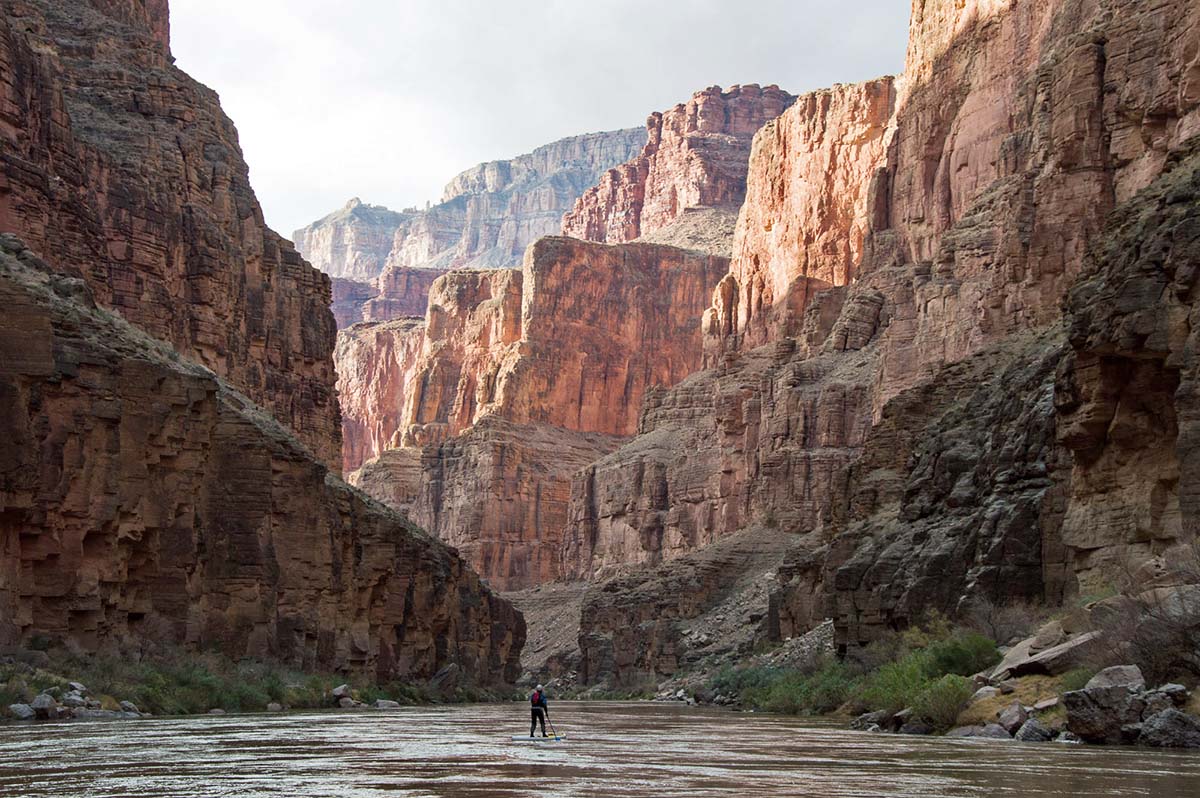
There essentially are two ways to earn a trip through the Grand Canyon, and neither is easy. The most common route is a commercial trip, wherein you pay a guide to take you and a crew of other customers down the river. Anyone with the funds can spend a summer vacation on a comfortable, catered raft trip with no experience necessary. If that sounds like the trip for you, then read no further. Simply enter ‘Grand Canyon rafting’ in your search bar, and your trip of a lifetime is only a phone call and hefty credit card payment away (trips running the full length can cost $5,000 or more).
The second option is the private permit. It takes less money but far more work and a fair amount of luck. Private means non-commercial: you don’t pay a guide, so you and the members of your crew must provide all of the planning, gear, and experience necessary to navigate the Grand Canyon. If that doesn’t sound daunting enough, consider the difficulty of even getting a private permit in the first place: the only way is through a lottery. Such a trip is for those who are determined, and for whom this article is written.
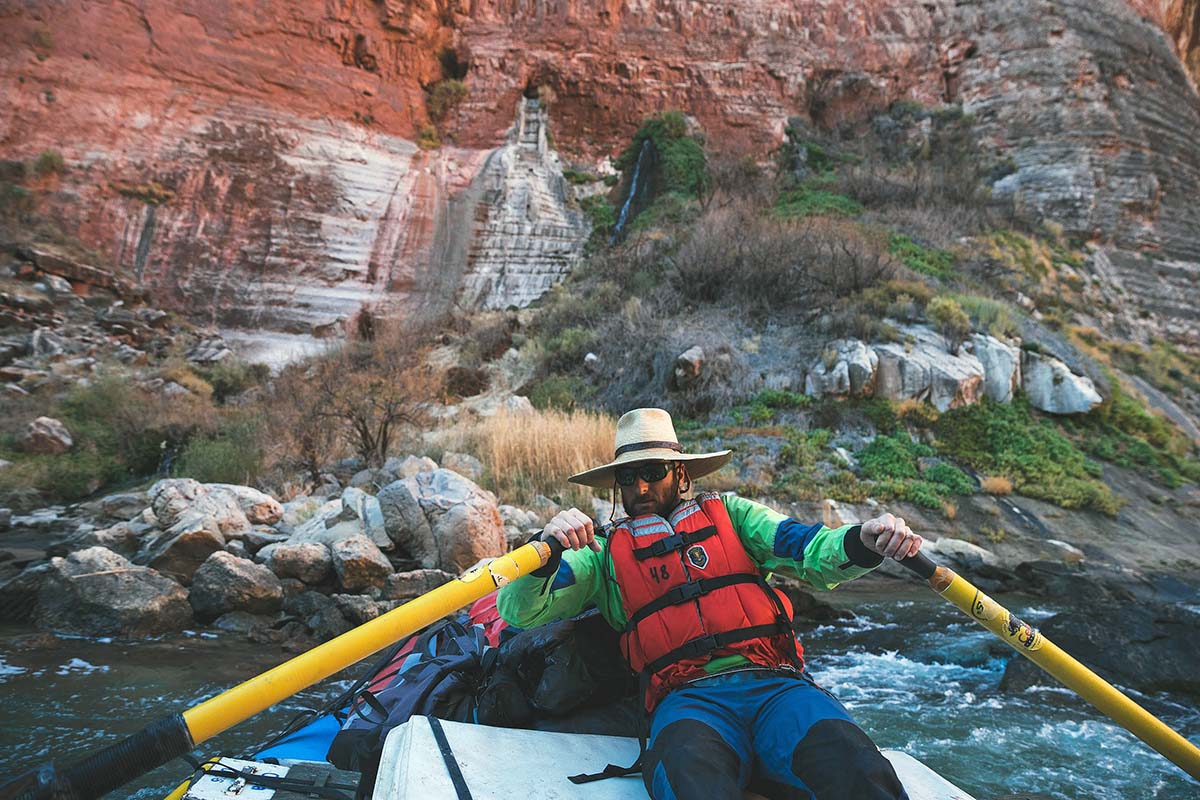
The Park Service uses a weighted lottery, in which the amount of entries granted to an individual depends on how recently he or she has been on the Grand Canyon. The number of years since you’ve done a river trip (commercial or private) equals your number of points, up to five. Points equal the amount of times your name is thrown in for the dates on your application. If you have never rafted the Canyon, your name will be put in five times for your selected dates. Once you go on a trip, whether or not the trip’s permit was awarded in your name, your points reset to one.
The dates you pick play into your chances as well, as certain dates are in higher demand than others. Many boaters seek the glamor of floating through the canyon on long, sunny days in 100-degree air, wearing flip flops and swimsuits. Summer trip hopefuls apply en masse year after year, but for most, the dream never is realized. Demand is so high that even an applicant with five points typically has a single-digit percent chance of winning a March to October launch date. With fewer points, you might as well forget about it. Your chances of winning a winter launch, however, may be over 50% if you have five points or even less. So if you really want to float The Grand, sunless days and freezing nights may be what you get.
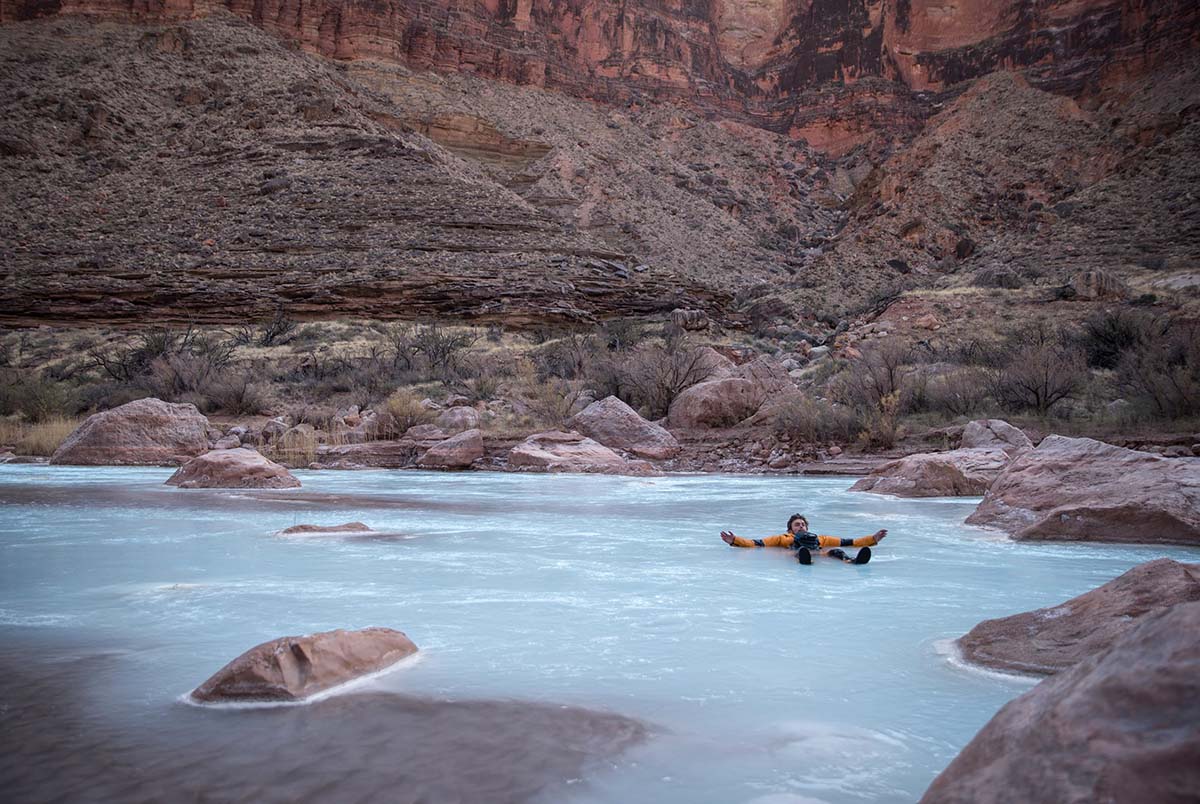
To apply, you must enter the lottery during the first three weeks of February—the application period for all launches in the following calendar year. Yes, you are applying for a trip 11 months or more in advance, but all you have to lose is the $25 application fee. If your entry wins, you are the trip leader. You will be responsible for direct communication with the Park Service, and the permit belongs to no one but you. You must secure it with a $400 deposit, which counts toward the total fee of $100 per person on the trip. There are plenty of other rules and nuances to the permitting process that applicants should know about, however. Look over the Noncommercial River Trip Regulations and Lottery FAQ before applying, and expect to become extremely familiar with them if you find yourself with a permit.
Long before I ever saw the Colorado for myself, an old boatman once told me, Lava Falls is “a rapid that sounds like a freight train colliding with a jet airliner.” Perhaps the most storied rapid in all of North America, if you have heard just one tale of rafting in the Grand Canyon, you’ve heard of Lava. Lava Falls cannot actually claim any Grand Canyon superlatives for longest rapid, biggest waves, highest consequence, or most difficult line, but it certainly earns honorable mention in all categories. Combined, they form a truly rowdy mess of whitewater that appears at first glance impassable. There is a line, however, that needs only a careful setup, calm maneuvering, and perhaps a drop of luck for a clean and glorious ride.
The rapids in Grand Canyon get difficulty ratings of 1-10, a system used only on this river and one that predates the standard Class I-V ratings used elsewhere. Lava Falls is considered a 9 at normal water levels. Class 10 is theoretically the hardest and most consequential that any rapid can be, but is reserved for when epicly high or low water levels raise the stakes.

Because they lack the overall chaos of Lava, the canyon’s other infamous rapids must settle for ratings of 7 or 8, even though some of these actually cause more carnage. Crystal (8) and Bedrock (7), for example, probably flip more rafts than any other. Even some rapids considered 5 or lower can easily deliver a beating to inexperienced or inattentive boaters.
Needless to say, prior experience is highly recommended (required, actually). By Park Service regulations, a minimum of one group member must have operated a boat through the entire Grand Canyon or river of similar difficulty before. You need not be that person yourself to win a permit, but you should have a plan for inviting able group members. Sure, some have skirted the rule, figured it out along the way, and come out just fine. And others—even some who meet the prerequisites on paper—have found themselves in over their heads and in need of expensive evacuations. So be aware—rafting the Grand Canyon is no pleasure cruise.
Unless you find a long-time veteran to join your trip, your best friend on the river will be guides of the printed variety. These contain necessary beta on rapids, useful descriptions of camps, recommendations for hikes, and interesting facts about geology, nature, and history. There is no best all-around book, as each author lends his or her own unique perspective and creative slant. In fact, traveling with multiple versions is smart. RiverMaps has the most detailed rapid and camp descriptions, plus accurate topographical maps. Belknap’s provides good maps as well as lots of information on of natural and human history. The Stevens Guide offers essential information in quickly digestible illustrations. Grand Canyon River Hikes describes the best excursions away from the boats. These are some of the most popular, but certainly not only, Grand Canyon guidebooks available.
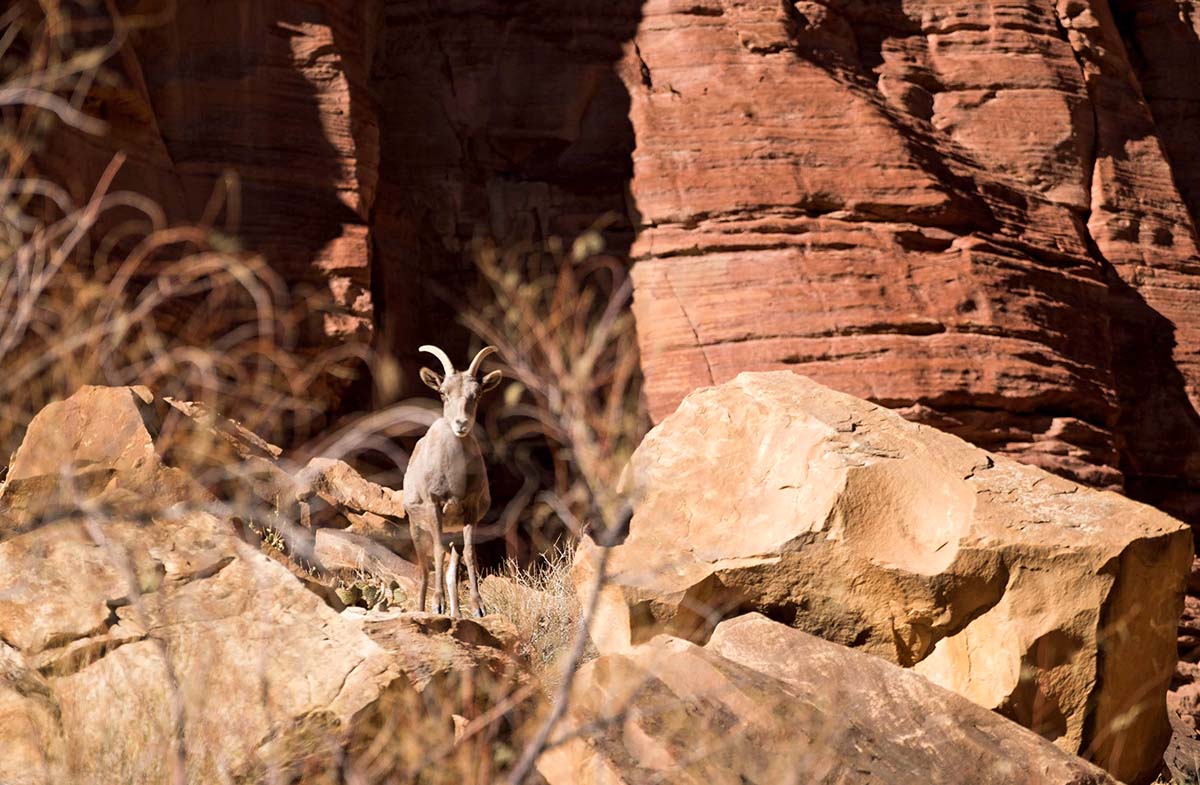
Other than games of chance with the rapids, the crux of any Grand Canyon trip is in the preparation. The advantage of the year-in-advance lottery is that if you win a trip, you have many months to plan it, and many months you will need. There are different levels of daunting depending on the sort of trip you want, but you should expect a headache no matter what. In theory, the simplest trip is a small number of people all self-supported in their own boats, wherein each person is responsible for their own packing. Most trips formed this way move light and fast due to limited carrying capacity. The most complicated is a trip maxed out on people and gear, where a few large rafts carry a tiny city’s worth of supplies that must be de-rigged and re-rigged at each camp. This makes for slower trips but a river life lived in relative luxury. You can decide based on your group’s resources and time commitment where you want to fall on the spectrum of complexity.
Almost no one owns the gear to equip an expedition of this magnitude, but don’t let that stop you. Outfitters are happy to lease all types of gear. You can rent from whomever you choose, but a handful of companies in Flagstaff, Arizona, with the Grand Canyon as their bread and butter, have the operation absolutely dialed. You can order a “painless private” package that takes care of boats and rigging, group kitchen and camp gear, food for the entire trip, shuttle to and from the river, and expert briefing on how to use it all. A quote on this service may seem through the roof, but consider the cost divided among all group members—minus the hassle you save by arriving in Flagstaff with minimal gear of your own—and the outfitter option is actually quite a good deal. Ceiba, Pro, Moenkopi, and Canyon REO are some companies to compare.
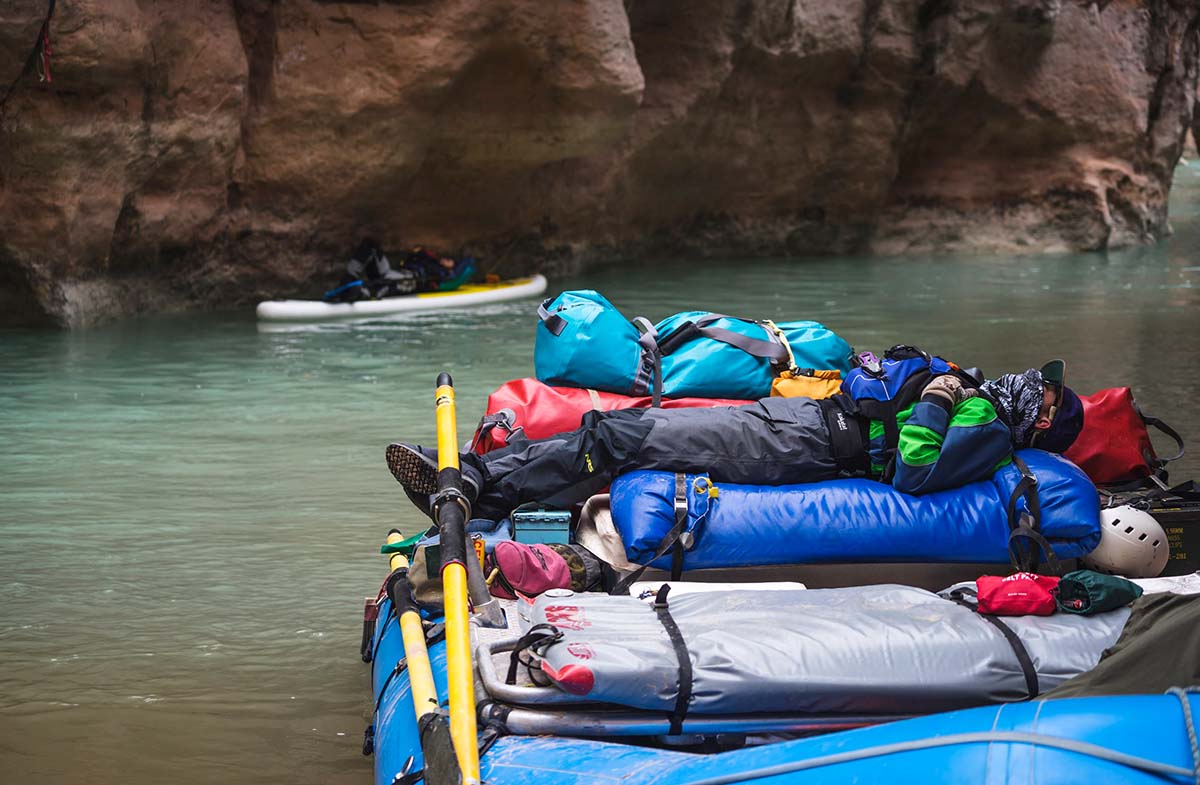
Then there is the river itinerary: each day’s mileage and rapids, each night’s camp, hikes not to be missed. This is the other huge half of the planning puzzle and the part that must be truly self-guided. In the Grand Canyon you do not have to declare your camps ahead of time like on some rivers, but you should have an idea of your schedule so that you can, at the very least, meet your shuttle on time. The level of detail between launch and takeout is personal preference. Planning to a T is one way to do it, but things can always change if a hike takes longer than planned, a rapid flips a boat, or a camp is already occupied.
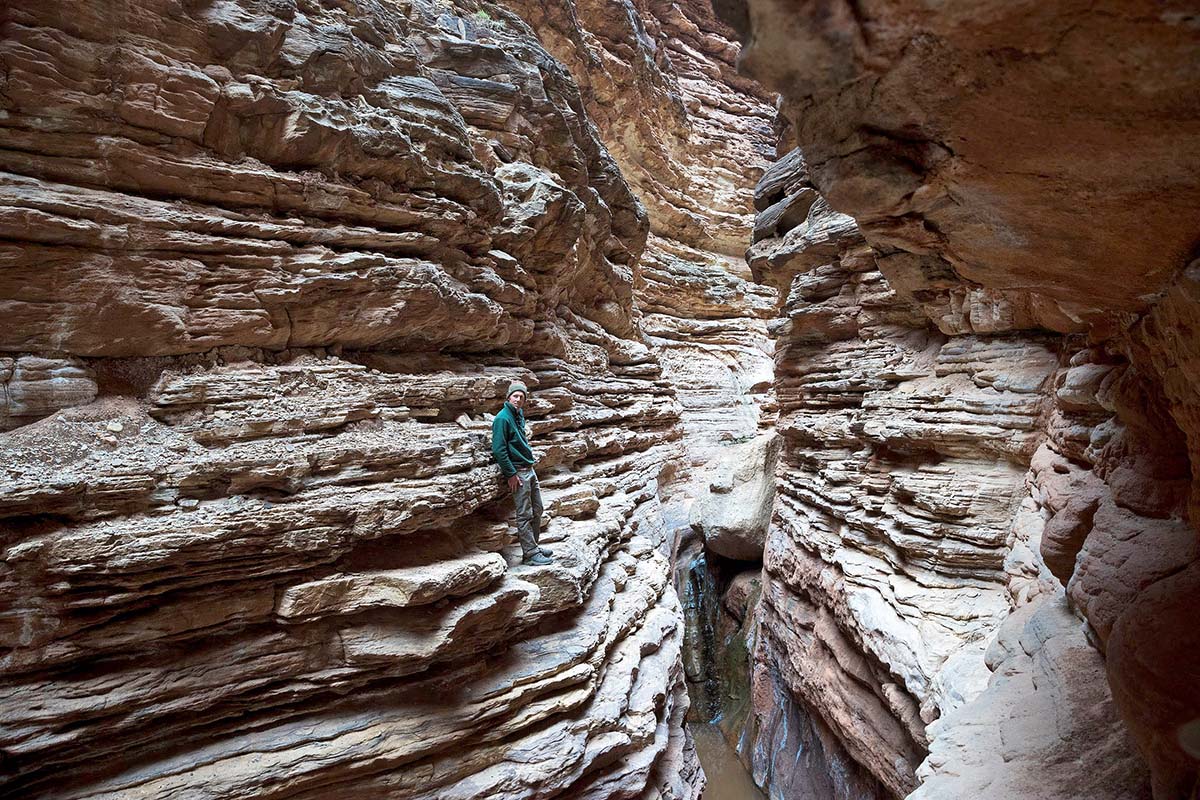
The Grand Canyon is blessed with beaches of soft sand that sweeps downriver from the surrounding desert and comes to rest against the canyon walls. These beaches come in all shapes and sizes, but many are large and flat enough to make fine camp spots. Along with the quality of the beach are factors like size and current of the eddy, aspect and amount of sun, shelter from the elements, and proximity to hikes that make camps more or less desirable. There also is the river mile at which they are located, which determines how they fit with the itinerary. Certain camps are more popular than others, and there always is the possibility that your intended spot will be taken with no room to share. And herein lies a huge advantage of winter trips: fewer groups on the river means less competition for camps. You are likely to find the space you need to stretch your legs, lay out your wet gear, and hope for a ray of sun before the end of each day.
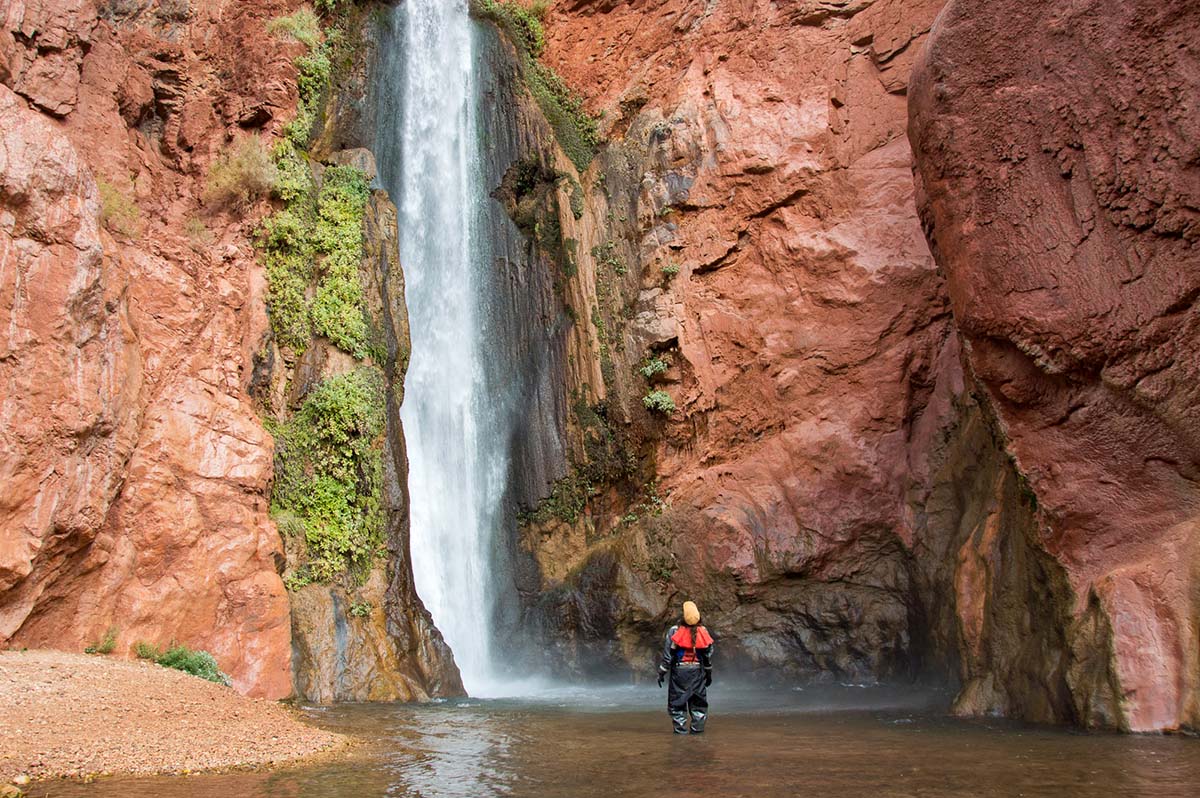
Gear for the Grand Canyon is similar to that of any other multi-day river trip, but there are a few specifics to be aware of. Most importantly is the Park Service required gear, which a ranger will check for at launch. Without essentials like a raised fire pan and human waste storage that meet NPS specifications, you won’t be allowed to launch. The full list is detailed in the Noncommercial River Trip Regulations. An outfitter will make sure these are included, along with other essentials to build your floating city. If you choose to outfit yourself, or to rent a less-than-total package, you should be well acquainted with the boats, rigging, and other equipment needed for a successful float trip. If you order a painless private, you will learn quickly out of necessity.
Just as important as group gear is personal gear, especially important in winter. A pair of boardshorts and a Hawaiian shirt will not suffice. Drysuits are mandatory, as are water and wind resistant tents, subfreezing sleeping bags, and multiple clothing layers. High-top rubber boots are a game changer for loading and unloading rafts in shallow water. Prepare for dampness (wear moisture-wicking baselayers), shivering (stuff hand warmers in gloves and clothing), cracked hands (use salves daily), dewy and icy mornings (diligently dry your gear whenever possible), and bad weather (water/windproof your camp and boats overnight). With proper planning and a positive attitude, you can win against the winter.
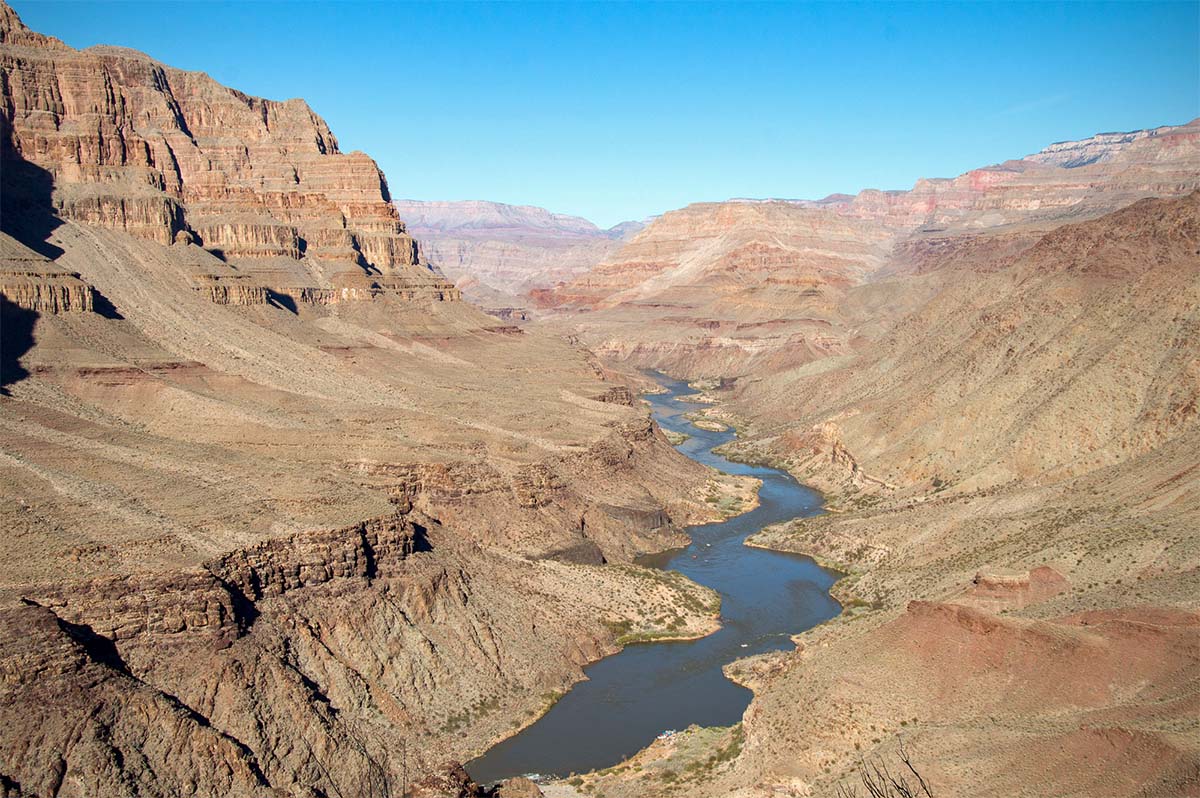
If by now you are still keen on organizing your own canyon trip, ask yourself a few crucial questions to review the feasibility of such a grand commitment.
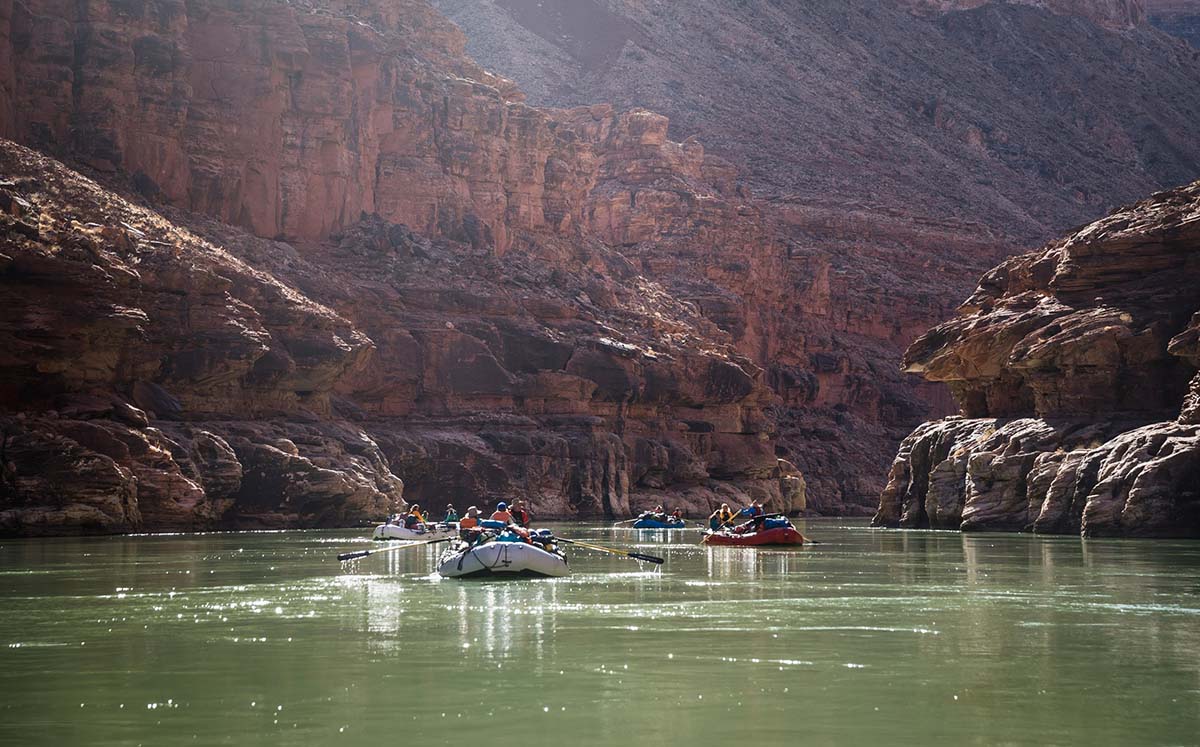
Jesse Weber is an adventure writer and creative consultant based in Arizona. You can see more of his work at unwearytraveler.com and follow him on Instagram @unwearytraveler.